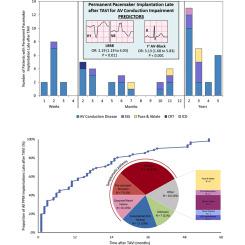Heart Rhythm ( IF 5.5 ) Pub Date : 2021-08-16 , DOI: 10.1016/j.hrthm.2021.08.010 Elena Elchinova 1 , Nikolas Nozica 1 , Joanna Bartkowiak 1 , Christoph Ryffel 1 , Benedikt Bernhard 1 , Mamdouh Elsmaan 1 , Babken Asatryan 1 , Mattia Branca 2 , Taishi Okuno 1 , Jonas Lanz 1 , Fabien Praz 1 , Stefan Stortecky 1 , Stephan Windecker 1 , Tobias Reichlin 1 , Thomas Pilgrim 1 , Laurent Roten 1

|
Background
Impairment of atrioventricular (AV) conduction may occur late after transcatheter aortic valve implantation (TAVI), and progression to complete AV block is a matter of concern.
Objective
The purpose of this study was to describe the incidence of permanent pacemaker (PPM) implantation late after TAVI.
Methods
In a prospective TAVI registry, we retrospectively identified patients with PPM implantation after hospital discharge for TAVI and analyzed serial electrocardiograms for AV conduction impairment before PPM implantation.
Results
Among 1059 patients discharged after TAVI without PPM between January 2012 and December 2017, 62 patients (5.9%) underwent PPM implantation at a median of 305 days after discharge for TAVI. Indications for PPM implantation late after TAVI were AV conduction impairment in 46 patients (74.2%); sick sinus syndrome in 10 (16.1%); cardiac resynchronization or implantable cardioverter-defibrillator indication in 2 (3.2%); and a pace and ablate strategy in 4 (6.5%). Clinical symptoms leading to PPM implantation late after TAVI included syncope in 19 patients (30.7%), presyncope in 7 (11.3%), and dyspnea in 8 (12.9%). First-degree AV block and new left bundle branch block (LBBB) after TAVI as well as valve-in-valve procedure during follow-up were independent predictors of PPM implantation late after TAVI due to AV conduction impairment.
Conclusion
PPM implantation late after TAVI is infrequent and is associated with clinical symptoms in half of patients. Impairment of AV conduction was the indication in three-quarters of patients. First-degree AV block and new LBBB after TAVI as well as valve-in-valve procedure during follow-up emerged as independent predictors.
中文翻译:

经导管主动脉瓣植入术后较晚植入永久性起搏器
背景
经导管主动脉瓣植入 (TAVI) 后可能会出现房室 (AV) 传导障碍,并且进展到完全 AV 阻滞是一个值得关注的问题。
客观的
本研究的目的是描述 TAVI 后晚期永久起搏器 (PPM) 植入的发生率。
方法
在一项前瞻性 TAVI 登记中,我们回顾性识别出院后因 TAVI 植入 PPM 的患者,并在 PPM 植入前分析连续心电图的 AV 传导障碍。
结果
在 2012 年 1 月至 2017 年 12 月期间,在没有 PPM 的 TAVI 后出院的 1059 名患者中,62 名患者(5.9%)在 TAVI 出院后的中位时间为 305 天接受了 PPM 植入。TAVI 后晚期 PPM 植入的适应症是 46 名患者 (74.2%) 的 AV 传导障碍;病态窦房结综合征 10 (16.1%); 心脏再同步化或植入式心脏复律除颤器适应症 2 (3.2%);以及 4 (6.5%) 的速度和消融策略。TAVI 后晚期导致 PPM 植入的临床症状包括 19 名患者 (30.7%) 晕厥、7 名晕厥前兆 (11.3%) 和 8 名 (12.9%) 患者呼吸困难。TAVI 后的一级 AV 传导阻滞和新的左束支传导阻滞 (LBBB) 以及随访期间的瓣中瓣手术是 TAVI 后由于 AV 传导障碍导致 PPM 植入的独立预测因素。
结论
TAVI 后晚期 PPM 植入并不常见,并且与一半患者的临床症状相关。AV 传导受损是四分之三患者的适应症。TAVI 后的 I 度 AV 阻滞和新的 LBBB 以及随访期间的瓣中瓣手术成为独立的预测因素。


























 京公网安备 11010802027423号
京公网安备 11010802027423号